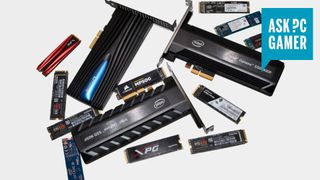Should I defrag my SSD?
A quick primer on defragmentation and when you should and shouldn't do it.

SSDs are now the storage of choice for enthusiasts and gamers alike. Some would even say they are the most impactful upgrade for your PC. They are smaller, faster, and have gotten much more reliable over the years. But do you need to defrag them? The short answer is no. The long answer is absolutely no.
Before we expand on this too much, it's worth explaining why defragging is beneficial for traditional hard drives.
HDDs operate using a physical spinning platter, with drive 'heads' that have to be positioned over the correct data. (Think of it like a vinyl record player, only much faster.) Data is stored on different sections of the platter in sequentially ordered blocks. In order to access a block for reading or writing, the drive heads need to be positioned over the correct sector, and then the desired block must pass under the drive heads. Combined, these two steps give the access time for a drive. For a typical 7,200 rpm drive, the rotational latency is 4.17ms (half of one rotation) and the seek time is around 8-12ms.
With usage, data that was once sequentially ordered on a drive can become split across different blocks. This is called fragmentation, and as this happens the drive heads need to access the data from two (or more—sometimes many more) different sections of the platter, drastically decreasing performance.
Defragmentation reorders the blocks of data sequentially and attempts to restore your hard drive's original performance. After the initial seek time to find the start of the data, everything after that is just sequentially pulling data from one block after another.
The reason there's no point defragmenting an SSD is that there's no seek time or rotational latency. Instead, SSDs access flash memory (NAND) at much higher speeds, typically less than 50us—that's 50 microseconds, or compared to a typical hard drive with a 15ms average access time, about 300 times faster. But there's more to the story than just speed.
SSDs don't just eliminate moving parts and improve access times, they also have built-in wear-leveling algorithms. The reason is that the NAND gates wear out over time, and are rated in program/erase cycles. Each cell in a modern SSD can be written to about 3,000 times before the cell stops working properly. To avoid individual cells that contain frequently changed data from wearing out faster, SSDs track usage of each block, and the wear-leveling algorithms ensure that over time, the cells on an SSD are written a similar number of times. There are also extra blocks that aren't user-accessible that the algorithms can use to keep the drives from wearing out.
The biggest gaming news, reviews and hardware deals
Keep up to date with the most important stories and the best deals, as picked by the PC Gamer team.
Because of the way SSDs work, not only does data not become fragmented but running a defragmentation utility will actually burn through the program/erase cycles and potentially cause premature 'death' of your SSDs. It's not something that would happen quickly—a 500GB Samsung 850 Evo as an example is rated for 150TB of total writes, or the equivalent of writing to every block of the drive at least 300 times. With typical users writing less than 20GB per day on average, it would require more than 20 years to burn through 150TB of writes. But defragmenting could easily write hundreds of GB of data, which would wear out an SSD much faster.
The good news is that any defragmentation program worth its salt should also detect the presence of an SSD and warn you not to defrag it. In the case of Windows Defrag, when it detects an SSD, it simply gives you the option of Optimizing the Trim, which frees up segments that have been marked as erased—something that it will do automatically once a week anyway. So no, there's no need to defrag an SSD.
Most Popular


